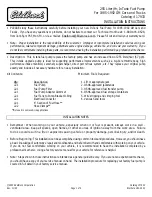
Catalog #17934
Brochure #63-0224
Page 2 of 5
©2004 Edelbrock Corporation
Rev. 2/04 - RS/mc
•
Note:
Steps shown in these instructions are intended as
a general guideline only. If you are not an experienced
mechanic, you should have a copy of your service
manual on hand. The installation procedure for replacing
your factory fuel pump is covered in full detail in your
factory service manual.
•
Note:
This rotary fuel injection pump will not work on
carbureted fuel systems. It is for electronic fuel injection
only.
•
Note:
The word “bracket” used throughout these
instructions refers to the fuel pump mounting bracket
and fuel level sender assembly.
PREPARATION
1. Make sure the engine is cool and the vehicle is on level
ground. Set the parking brake.
2. Relieve any pressure in the fuel tank by removing the
gas cap.
3. Relieve the fuel system pressure.
(Note: If this
procedure is not followed, damage to the
injector(s) and/or other fuel system components
could occur.)
. Begin by locating and unplugging the
fuel injector wiring harness. Ground one terminal.
Apply battery voltage to the other terminal for five to
ten seconds to open the injector. This procedure is
necessary to prevent fuel from spraying when
disconnecting fuel lines. Spraying fuel could result in a
fire hazard.
4. Remove the negative (ground) cable from the battery
and position it so that it cannot make a connection to
the battery during the fuel pump installation procedure.
5. Some vehicles require removal of the fuel tank to
access the fuel pump bracket. Some require removing
the rear seat, an access panel, and possibly the trunk
liner to access the pump bracket. In those vehicles that
require fuel tank removal, see the “Fuel Tank Removal”
section. On those that do not, remove the necessary
items and gain access to the top of the fuel tank and
the fuel pump bracket and continue on to the
“Bracket
Removal”
section.
INSTALLATION PROCEDURE
FUEL TANK REMOVAL
(Caution: The fuel tank can be quite awkward to
remove due to its size and weight. Obtain help
during its removal).
(Note: The following instructions may not be specific
to your particular vehicle. See your factory service
manual for specific instructions).
1. Drain the fuel tank. Use an OSHA-approved gasoline
transfer pump, and remove as much fuel as possible
through the fuel tank filler neck. Store the fuel in
approved safety containers only.
2. Lift and safely support the vehicle with approved safety
stands with enough height to gain clearance to remove
the fuel tank. If lifting only the rear of the vehicle,
remember to block the front wheels.
3. Once the vehicle is lifted and supported, an alternate
method of fuel removal may be implemented.
Determine which line is the fuel return line going back
to the fuel tank
(See Fig. 1)
. Trace the return line back
from the injectors and remove it from the bracket.
Securely attach a hose to the exposed fuel return tube
leading into the tank, and draw the remaining fuel out
and into an approved container.
(Note: Regardless of the method used to remove fuel
from the tank, it is important to remove as much fuel
as possible before removing the tank. This is
required to help prevent fuel spillage, and injury from
excessive weight while removing the tank).
Fig. 1
Fuel Tank
Fuel Pressure Regulator
Fuel Return Line
Injector(s)
Fuel Filter
Vapor Canister
Typical Fuel System























